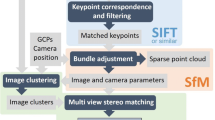Abstract
High-resolution digital imagery of sediment cores increases researchers’ ability to examine, review, and disseminate complex and meaningful core data. The high cost of commercial core scanning systems currently limits the number of cores that are imaged. Here, we present a simple, inexpensive system that can be built in almost any laboratory environment and used to create complete core images. This system uses a stationary light source and a moving core tray (sledge) which provides for consistent lighting across multiple images. Polarized lens filters and diffuse light are used to minimize glare on the core surface. Our system also repurposes professionally engineered exercise equipment which, provides for precise core and camera movement. Once images are taken, stitching software is used to create the final core image. While there are many stitching programs on the market, none are explicitly aimed at stitching together many images in a single, straight line. We evaluated seven of the most common stitching programs and identified Hugin as the most useful for creating completed core images.


Similar content being viewed by others
References
Christensen JQ, Björck S (2001) Digital sediment colour analyses, DSCA, of lake sediments-pitfalls and potentials. J Paleolimnol 25:531–538
Dersch H (2007) Panorama tools: open source software for immersive imaging. In: The international VR photography conference proceedings, p 1
Lamoureux SF, Bollman J (2004) Image acquisition. In: Francus P (ed) Image analysis, sediments and paleoenvironments. Kluwer Academic Publishers, Dordrecht, pp 11–23
McMillan K (2008) An inexpensive system for continuous lake core photography. J Paleolimnol 40:1179–1185
Nederbragt AJ, Thurow JW (2004) Digital sediment colour analysis as a method to obtain high resolution climate proxy records. In: Francus P (ed) Image analysis, sediments, and paleoenvironments. Kluwer Academic Press, Dordrecht, pp 105–119
Nederbragt AJ, Dunbar RB, Osborn AT, Palmer A, Thurow JW, Wagner T (2006) Sediment colour analysis from digital images and correlation with sediment composition. In: Rothwell RG (ed) New techniques in sediment core analysis, vol 267. Geological Society, London Special Publications, pp 113–128
Acknowledgments
We would like to thank Chris Van Rooyen for help in designing and constructing the core scanner. Jacquie Smith, Amy Myrbo, and two anonymous reviewers provided comments that significantly improved the manuscript. Davidson College provided funding and surplus materials for construction of the core scanner.
Author information
Authors and Affiliations
Corresponding author
Rights and permissions
About this article
Cite this article
Johnson, B.G. Recommendations for a system to photograph core segments and create stitched images of complete cores. J Paleolimnol 53, 437–444 (2015). https://doi.org/10.1007/s10933-015-9831-9
Received:
Accepted:
Published:
Issue Date:
DOI: https://doi.org/10.1007/s10933-015-9831-9




